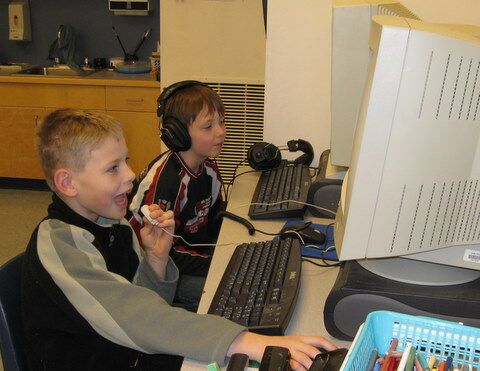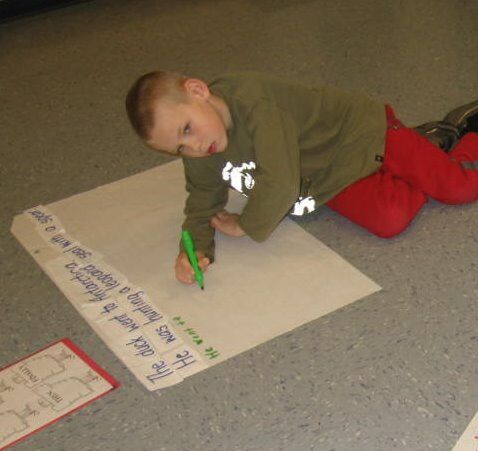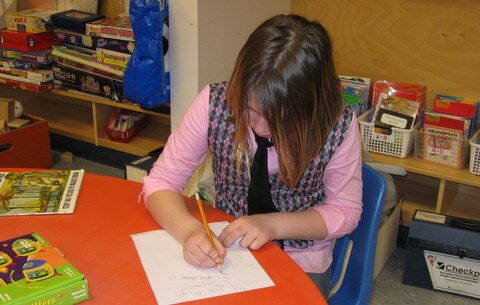These days, a glance around my classroom during writing time always makes me smile. The view is vastly different from the quiet hum of scratching pencils that I used to pride myself on. Most days, a visitor would notice a couple of students lying on their bellies writing with big markers on chart paper, others sitting in desks using table-top keyboards or laminated graphic organizers with overhead markers. At the side of the room, a couple of students are on the computer, composing in Microsoft Word or Kurzweil, or perhaps recording a voice prompt in Kidspiration. And of course, many are at their desks, writing with pencils in their notebooks. Everyone has a preferred way to bring the “technicolor dream” of his or her own imagination to life.
 Strewn across the students’ desks are rubrics, word lists and graphic organizers that they used for planning their work. A handful of published stories clutter the carpet area, and a few kids are leaning in chatting over the text we’ve shared before “Time to Write” began. It’s far from quiet, but everyone’s engaged. With everyone working, I’m able to move from student to student, helping to label drawings, chatting over strategy and celebrating successes. It’s a rare day when I find myself sitting with someone who is staring at a blank page.
Strewn across the students’ desks are rubrics, word lists and graphic organizers that they used for planning their work. A handful of published stories clutter the carpet area, and a few kids are leaning in chatting over the text we’ve shared before “Time to Write” began. It’s far from quiet, but everyone’s engaged. With everyone working, I’m able to move from student to student, helping to label drawings, chatting over strategy and celebrating successes. It’s a rare day when I find myself sitting with someone who is staring at a blank page.
This enthusiasm stems from two places: sharing literature and conversation as part of a six-traits writing program, and experiencing the choice and flexibility afforded by universally designed lessons. Blending these strategies together allows me to create an atmosphere where ideas flow and excitement builds, while barriers to writing are non-existent.
Universal Design for Learning (UDL)
A universally designed curriculum is one that has been designed from the outset to allow all students to access it. In “Smart From the Start,” Pischa and Coyne explain that educators must “think about the needs of the entire range of learners who are…in today’s classrooms, and then design curricula, materials, methods and environments that support and challenge each learner as appropriately and consistently as possible.” 1 By using this UDL framework, I do not adapt or modify lessons to meet students’ needs after the fact, but instead, I design my lessons to accommodate a variety of student needs from the beginning.
 There are three main principles of universal design: multiple means of representation (how the concept is introduced); multiple means of engagement (how the students interact and practice with the material); and multiple means of expression (how students demonstrate their learning). Often, but not always, this means employing technology in the lesson. It also means being flexible and open enough to provide an array of choices and experiences for students. For me, the six-traits writing framework is the perfect model to provide a universally designed experience for young writers.
There are three main principles of universal design: multiple means of representation (how the concept is introduced); multiple means of engagement (how the students interact and practice with the material); and multiple means of expression (how students demonstrate their learning). Often, but not always, this means employing technology in the lesson. It also means being flexible and open enough to provide an array of choices and experiences for students. For me, the six-traits writing framework is the perfect model to provide a universally designed experience for young writers.
Six-Traits Writing
The Northwest Regional Educational Laboratory (www.nwrel.org/index.php) describes six-traits writing as “a powerful way to learn and use a common language to refer to characteristics of writing as well as create a common vision of what ‘good’ writing looks like.”2 The six traits are: ideas, organization, writing fluency, word choice, voice and conventions, and sometimes, the “+1 trait,” presentation. With teacher support and guidance, students explore published literature, rubrics and exemplars to gain an understanding of each of these traits, and then use this knowledge and set of tools to plan and revise their own writing.
The “UDL” Writing Program
 We begin our six-traits lessons by sharing a piece of published writing. Through read-alouds and structured partner talk, as well as by completing charts and graphic organizers, we fulfill the first principle of UDL—multiple means of representation. Students further explore the identified trait by reading other published stories, and by examining exemplars or personal writing, in relation to a rubric. Often, we develop these rubrics together, and our conversation both guides the students’ understanding of the trait, and illuminates ways for them to employ it in their own writing.
We begin our six-traits lessons by sharing a piece of published writing. Through read-alouds and structured partner talk, as well as by completing charts and graphic organizers, we fulfill the first principle of UDL—multiple means of representation. Students further explore the identified trait by reading other published stories, and by examining exemplars or personal writing, in relation to a rubric. Often, we develop these rubrics together, and our conversation both guides the students’ understanding of the trait, and illuminates ways for them to employ it in their own writing.
The second principle of UDL is multiple means of engagement. In my classroom, this means offering students a multitude of choices during the “Time to Write.” Allowing children to select their own “writing tool” frees them up to think about their ideas and their goals. Visual learners often choose to begin by drawing, and sometimes labeling, pictures on a graphic organizer. More verbal learners might choose to chat with a friend to clarify their thinking before starting, or to record their story into a microphone before committing it to paper or a keyboard. Some prefer the tabletop “Writer” keyboards or programs like Kurzweil or Clicker 5 that offer word prediction support. None of these things are “special tools” for students who have difficulty writing. They are choices that are available to everyone. My students know and understand that good writing isn’t about being a neat printer or perfect speller. It’s about deepening our understanding of the trait we are exploring, and about systematically and deliberately employing the strategies shared by other powerful writers.
 The third principle of UDL is multiple means of expression. I believe that it’s always more motivating to write for an audience. When you’ve been engaged with the work in a variety of ways, it only makes sense to have choice in how you celebrate what you’ve created. Some of my students quietly share their work with the teacher or take it down the hall to read to the secretary. Others enjoy sharing it with a friend, or hanging it on the wall. A few will ask me to share it aloud, while others enjoy the limelight of reading it from the “Author’s Chair.” Many find it quite exciting to email a voice recording to a parent, or to show off a completed storyboard to the group.
The third principle of UDL is multiple means of expression. I believe that it’s always more motivating to write for an audience. When you’ve been engaged with the work in a variety of ways, it only makes sense to have choice in how you celebrate what you’ve created. Some of my students quietly share their work with the teacher or take it down the hall to read to the secretary. Others enjoy sharing it with a friend, or hanging it on the wall. A few will ask me to share it aloud, while others enjoy the limelight of reading it from the “Author’s Chair.” Many find it quite exciting to email a voice recording to a parent, or to show off a completed storyboard to the group.
In my room, we know that good writers express themselves in a clear and purposeful way. Students who are personally engaged in the material, and who have developed a vision of how a particular trait is represented in a variety of texts, are able to explain their learning, and to demonstrate it in other contexts.
I believe that blending a six-traits program with the flexibility of an UDL environment makes a profound difference in a short time. This fall, I began working with a group of ten grade four and five students who had never met expectations for writing. When I evaluated their writing at the end of February, four of them fully met expectations, and another four are minimally meeting them. These learners speak in an articulate way about their goals and progress, and they know how to use rubrics to challenge themselves to move forward. But, even more exciting for me, is the fact that no one is left to sit in an anxious silence beside a blank page. Instead, we’re all working together to build a toolkit that will help us to bring our “Technicolor Dreams” to life.
1 Coyne, Peggy and Bart Pischa, “Smart from the Start: The Promise of Universal Design for Learning,” Remedial and Special Education, v.22, no. 4, July/Aug. 2001, pp. 197-203.
2 Retrieved from: http://www.nwrel.org/assessment/department.php?d=1, January 30, 2009
ABOUT THE AUTHOR
Kerri Steel
Kerri Steel is the Learning Resource Teacher/Vice Principal at Errington Elementary School in Qualicum, BC. She has completed a Masters of Arts degree in Leadership and Administration, with a focus on Universal Design for Learning. She has led workshops and facilitated staff development activities in UDL and Six-Traits Writing.
This article is from Canadian Teacher Magazine’s September 2009 issue.












